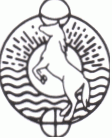|
The following was on the inside
cover of the first Dawn Horse Magazine, Vol. 1, Number 1,
May 1974.
 THE THE
DAWN HORSE
see
newer image
The name of this magazine, like The
Dawn Horse Communion itself, refers to a visionary symbol
which appeared to Bubba as he wandered consciously during
sleep in the spring of 1970, not long before the events in
the Vedanta Temple.
He appeared in the Ashram of a
Siddha who was proficient in the siddhi, or yogic power, of
spontaneously manifesting objects. Only men were present;
they were the disciples of this Siddha, learning to develop
this same power themselves. The Siddha was seated in a large
throne-like chair, and his disciples were standing before
him in rows, in two large groups so that there was a pathway
leading out in front of his chair. Bubba was standing among
these men.
The Siddha began to initiate the
process of manifestation. Everyone sat quietly for a time,
and then the disciples started to get up and leave the room.
They were all satisfied; it had been done. But nothing had
appeared. They wandered away and the Siddha remained sitting
quietly in his chair. Bubba stayed where he was, and
suddenly a horse began to appear. At first it was vaporous
and indistinct, but gradually it solidified and became
crisply defined. The horse was perfectly formed, much like a
thoroughbred, but very small, perhaps three feet high. It
was alive, but it stood without moving.
Bubba remembers bringing this
“dream” into his conscious mind as he woke up.
There was something about it that
was hidden, so it remained with him as a symbol. After his
realization in the Vedanta Temple and the development of his
function as Guru over the next few months, it became clear
to him exactly what had occurred. He was no longer there to
recall it from the mind’s point of view; he could reconnect
directly with the situation itself. He could see that this
wasn’t just a siddha practicing the yogic siddhi of
manifesting something from nothing. This was the Very
Divine, the Maha-Siddha, shown in a visionary form revealing
the nature of the creation of the manifest world, the nature
of His relationship to it, and the nature of the world
itself. This world appears to be very solid, like the horse,
but it’s a spontaneous creation, subject to the conscious
process. At every moment, the visible worlds are utterly
dependent upon the Divine, who is the present and continuing
creator, not the one who made everything long ago in some
unique and magnificent power.
As an archetype of the relationship
between this world and the Divine, this dream implies
something about the way life should be lived once this
relationship is known or can be intuited. In Satsang the
Guru demonstrates this to the intuition, and restores the
awareness of devotees to clear understanding of their
present dependence upon God. The disciples in Bubba’s dream
were intuiting this Real Process rather than
involving themselves with the evidence of it. They knew that
the manifestation had been accomplished without having to
wait and see the horse itself appear.
The creation of the horse is also a
symbol for Bubba’s creative work in the world. The Divine is
spontaneously manifesting this community and its development
over time like anything else that can be seen. Soon after
Bubba opened the Ashram he named it “Shree Hridayam” which
refers to the Sanskrit name for the Heart, “that into which
all things return in the end.” Bubba encountered (watching a
science-fiction movie) the scientific name for the first
known ancestor of today’s horse, “Iohippus,” Greek for “dawn
horse,” and he liked that as a name for the horse he had
seen. Thus, when he decided not to associate his work with
Indian or other traditions, he changed its name to “The Dawn
Horse Communion.”
As it appears on the cover of this
magazine, the logo of The Dawn Horse Communion is a symbol
for the nature of life and consciousness and their immediate
dependence upon the Divine, the Heart. At the bottom of the
logo is a small circle crossed by two lines. This is a sign
for the earth, the solid element, and the horse’s feet are
there. Above that, wavy lines symbolize water and the watery
levels of being; the lower body of the horse passes through
this. At the center of the large outer circle is a smaller
one representing the sun. The heart of the horse, if shown,
would be at the center of this circle. The sun represents
the fiery element. The horse’s heart symbolizes the Very
Heart, God. The horse’s upper body passes through the air,
which also symbolizes its element. In the logo, the rays of
the sun are represented here. The horse’s head rests in
another small circle, the moon. The moon represents the
mind, including the high or illumined states of
consciousness. All of these are a reflection of the Heart,
just as the moon only reflects the light of the sun. The
curve of the horse’s neck represents the S-curve of the
Amrita Nadi, the open channel of light between the Heart and
the point at the top of the head at which the Divine Light
is intuited.
|
 THE
THE